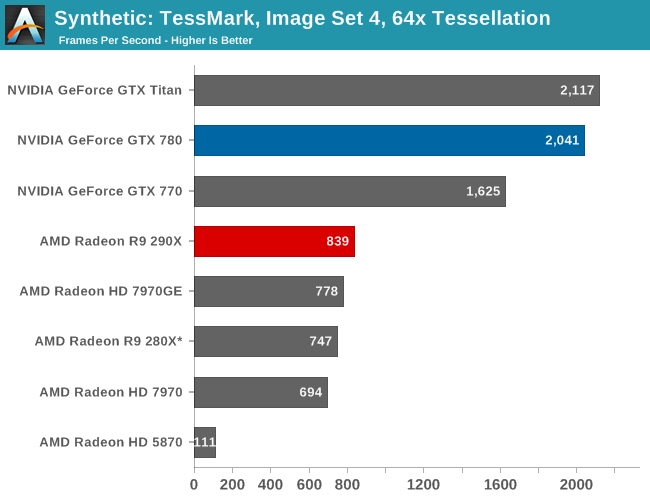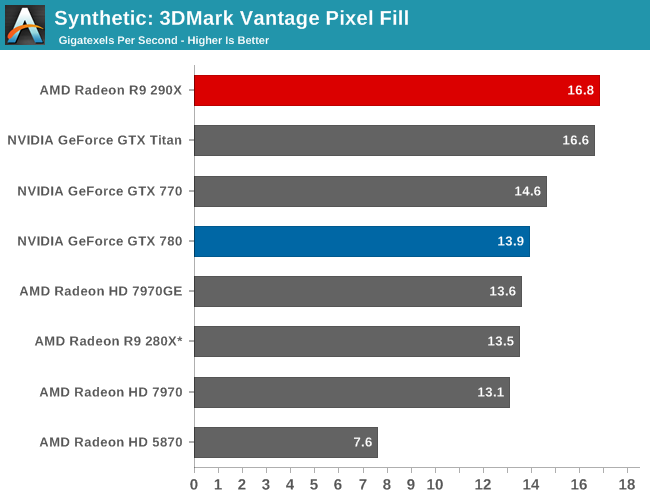The AMD Radeon R9 290X Review
by Ryan Smith on October 24, 2013 12:01 AM EST- Posted in
- GPUs
- AMD
- Radeon
- Hawaii
- Radeon 200
Synthetics
As always we’ll also take a quick look at synthetic performance. The 290X shouldn’t pack any great surprises here since it’s still GCN, and as such bound to the same general rules for efficiency, but we do have the additional geometry processors and additional ROPs to occupy our attention.

Right off the bat then, the TessMark results are something of a head scratcher. Whereas NVIDIA’s performance here has consistently scaled well with the number of SMXes, AMD’s seeing minimal scaling from those additional geometry processors on Hawaii/290X. Clearly Tessmark is striking another bottleneck on 290X beyond simple geometry throughput, though it’s not absolutely clear what that bottleneck is.
This is a tessellation-heavy benchmark as opposed to a simple massive geometry bencehmark, so we may be seeing a tessellation bottleneck rather than a geometry bottleneck, as tessellation requires its own set of heavy lifting to generate the necessary control points. The 12% performance gain is much closer to the 11% memory bandwidth gain than anything else, so it may be that the 280X and 290X are having to go off-chip to store tessellation data (we are after all using a rather extreme factor), in which case it’s a memory bandwidth bottleneck. Real world geometry performance will undoubtedly be better than this – thankfully for AMD this is the pathological tessellation case – but it does serve of a reminder of how much more tessellation performance NVIDIA is able to wring out of Kepler. Though the nearly 8x increase in tessellation performance since 5870 shows that AMD has at least gone a long way in 4 years, and considering the performance in our tessellation enabled games AMD doesn’t seem to be hurting for tessellation performance in the real world right now.
Moving on, we have our 3DMark Vantage texture and pixel fillrate tests, which present our cards with massive amounts of texturing and color blending work. These aren’t results we suggest comparing across different vendors, but they’re good for tracking improvements and changes within a single product family.

Looking first at texturing performance, we can see that texturing performance is essentially scaling 1:1 with what the theoretical numbers say it should. 36% better texturing performance over 280X is exactly in line with the increased number of texture units versus 280X, at the very least proving that 290X isn’t having any trouble feeding the increased number of texture units in this scenario.

Meanwhile for our pixel fill rates the results are a bit more in the middle, reflecting the fact that this test is a mix of ROP bottlenecking and memory bandwidth bottlenecking. Remember, AMD doubled the ROPs versus 280X, but only gave it 11% more memory bandwidth. As a result the ROPs’ ability to perform is going to depend in part on how well color compression works and what can be recycled in the L2 cache, as anything else means a trip to the VRAM and running into those lesser memory bandwidth gains. Though the 290X does get something of a secondary benefit here, which is that unlike the 280X it doesn’t have to go through a memory crossbar and any inefficiencies/overhead it may add, since the number of ROPs and memory controllers is perfectly aligned on Hawaii.










396 Comments
View All Comments
TheJian - Friday, October 25, 2013 - link
Wrong, Zotac price in cart $624. :) Personally I'd buy an OC card for $650 but that's just me.http://www.newegg.com/Product/Product.aspx?Item=N8...
46andtool - Thursday, October 24, 2013 - link
your comment makes no sense, all I see are excuses and misinformation in your post." It doesn't cost less than a GTX780, it only has a lower MSRP." is just stupid, battlefield 4 edition 290xs are already on newegg for $579, the only cheap 780gtxs you will find will be used ones.chrnochime - Thursday, October 24, 2013 - link
What 549? Every 780 on NE goes for 649. I want some of the kool-aid you're drinking.HisDivineOrder - Friday, October 25, 2013 - link
It IS loud. HardOCP have a tendency to be so "hard" they ignore the volume of the card. They aren't the most reliant of sites about the acoustics of a card. Not in the past and not today.JDG1980 - Thursday, October 24, 2013 - link
Regarding 1080p performance, so what? You don't need a $500+ video card to get acceptable frame rates at that resolution. A $200-$300 card will do just fine. $500+ video cards are for multi-monitor setups or high resolution (1440p+) displays.Regarding the noise, that's a problem - AMD clearly stretched things as far as they could go with GCN to reach the current performance level. I know that EK has already announced a 290X waterblock for those enthusiasts who use custom loops. I wouldn't be surprised to see someone come out with a self-contained closed-loop watercooler for the 290X, similar to those that have been available for CPUs for a couple years now. That might help fix the noise issues, especially if it used a dual 120mm/140mm radiator.
46andtool - Thursday, October 24, 2013 - link
we are just now breaking 60fps on 1080p on demanding games at max details, and even more demanding games are just around the corner so your telling people what exactly? And everybody knows AMD makes retarded reference coolers. So another moot point. Lets-try-and -discredit- AMDs- stellar -new product -anyway -we -can- but- the- only- way- we -know -how -is -by -grasping- at- straws.inighthawki - Thursday, October 24, 2013 - link
BS, there's absolutely nothing wrong with a high end card on a 1080p display. Just look at the benchmarks, Crysis 3 1080p on high, a 7970GE barely hits 60fps, and no doubt that will drop below 60 on many occasions (it's just an average). On top of that, not all games are nearly as well optimized as Crytek games, or are just far more complex. Total War: Rome 2, even the 290X doesn't barely hits 60fps on extreme with MEDIUM shadows. Or maybe look at Company of Heroes 2, and how even the 290X hits a min fps of 37fps on extreme.On top of all of that, high resolution IPS panels are super expensive, not everyone cares enough about that to spend the money. The difference between a quality 1080p and a quality 1440p panel can be almost as much as the video card itself.
patrioteagle07 - Thursday, October 24, 2013 - link
Not really... You can find refurbed ZR30s for under $600If you are going to spend 1k on gfx its rather short sighted to keep your TN panels...
inighthawki - Thursday, October 24, 2013 - link
That's at LEAST several hundred dollars more than the majority of people are willing to spend on a monitor. 1080p TN panels are fine for most people, including most gamers. What people care about is not monitor count, pixel count, or color accuracy. They want high quality shaded pixels and good framerate. This is where high end video cards on smaller monitors comes into play. There are plenty of reasons to do it. Do not confuse your own values as the same as what everyone else wants.ShieTar - Friday, October 25, 2013 - link
Also, an increasing number of players is considering 120 FPS to be the acceptable framerate, not 60FPS.